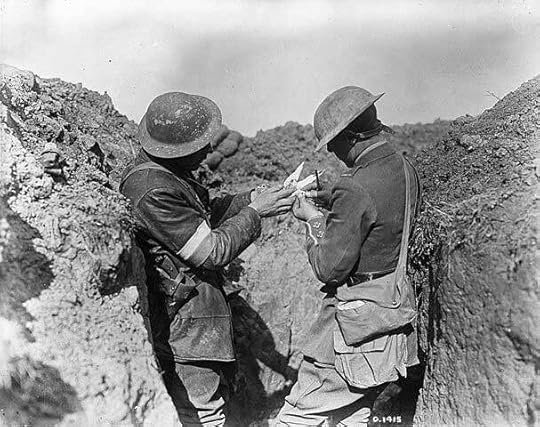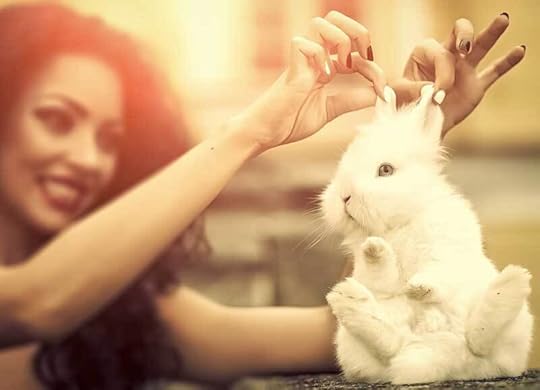Stan C. Smith's Blog, page 16
January 25, 2023
Awesome Animal Fact - Tree-climbing Margay
Continuing with the theme of RIDICULOUSLY CUTE WILD CATS.
Did you know there is a small wild cat called the margay that is so good at climbing trees that it can run down a tree trunk headfirst? Weighing less than 9 pounds (4 kg), margays have an extra-long tail, which helps them keep their balance while maneuvering through the trees. Also, their ankles can rotate 180 degrees (like a squirrel!).
Margays live in Central and South America and are related to the larger ocelot. Normally hunting in trees, they are ambush hunters, waiting patiently for the perfect time to pounce on a monkey, bird, lizard, tree frog, or large insect or spider. They also raid bird nests and eat the eggs.
Amazingly, margays have been observed mimicking the sounds of small monkeys as a hunting strategy. The monkeys, attracted by the mimicked sounds, come close enough for the margay to pounce.
Male Margays perform an elaborate "dance" sequence to woo their mates. When in estrus, the females attract males with a long, moaning call. When the males approach, they yelp and trill, and rapidly shake their head back and forth, a mating ritual not seen in any other types of cats.

Photo Credits:
- Margay - DepositPhotos
Did you know there is a small wild cat called the margay that is so good at climbing trees that it can run down a tree trunk headfirst? Weighing less than 9 pounds (4 kg), margays have an extra-long tail, which helps them keep their balance while maneuvering through the trees. Also, their ankles can rotate 180 degrees (like a squirrel!).
Margays live in Central and South America and are related to the larger ocelot. Normally hunting in trees, they are ambush hunters, waiting patiently for the perfect time to pounce on a monkey, bird, lizard, tree frog, or large insect or spider. They also raid bird nests and eat the eggs.
Amazingly, margays have been observed mimicking the sounds of small monkeys as a hunting strategy. The monkeys, attracted by the mimicked sounds, come close enough for the margay to pounce.
Male Margays perform an elaborate "dance" sequence to woo their mates. When in estrus, the females attract males with a long, moaning call. When the males approach, they yelp and trill, and rapidly shake their head back and forth, a mating ritual not seen in any other types of cats.

Photo Credits:
- Margay - DepositPhotos
Published on January 25, 2023 06:48
January 19, 2023
Awesome Animal Fact - Thirsty Sand Cat
For the next few posts, I'm focusing on the theme of RIDICULOUSLY CUTE WILD CATS.
Did you know there is a tiny wild cat, called the sand cat, that inhabits extremely dry deserts of Africa and the Middle East? The sand cat (with the awesome scientific name of Felis margarita) only weighs 3 to 7 pounds (1.4 to 3.2 kg), and has an unusually wide face.
Sand cats sleep in their burrows during the day and come out at night to hunt small rodents, birds, lizards, insects, spiders, and even venomous snakes. They hunt by skulking around with their ears close to the sand, using their super-duper hearing ability to detect animals digging or slithering underground. When they hear one, they start digging really fast to get to the prey animal before it escapes.
Sand cats regularly go weeks at a time without drinking water, getting the moisture they need from the bodies of the prey animals they eat. The photo below is a wild sand cat... not a domestic cat.
Photo Credits:
- Sand cat - DepositPhotos
Did you know there is a tiny wild cat, called the sand cat, that inhabits extremely dry deserts of Africa and the Middle East? The sand cat (with the awesome scientific name of Felis margarita) only weighs 3 to 7 pounds (1.4 to 3.2 kg), and has an unusually wide face.
Sand cats sleep in their burrows during the day and come out at night to hunt small rodents, birds, lizards, insects, spiders, and even venomous snakes. They hunt by skulking around with their ears close to the sand, using their super-duper hearing ability to detect animals digging or slithering underground. When they hear one, they start digging really fast to get to the prey animal before it escapes.
Sand cats regularly go weeks at a time without drinking water, getting the moisture they need from the bodies of the prey animals they eat. The photo below is a wild sand cat... not a domestic cat.

Photo Credits:
- Sand cat - DepositPhotos
Published on January 19, 2023 08:33
January 15, 2023
Awesome Animal Fact - Green Sloths
Did you know sloths are so slow that algae grows on their fur? Well, algae does grow on their fur, but not necessarily because they are slow moving. Sloths have actually formed a symbiotic relationship with the algae. So, sloths actually encourage the algae to grow on their fur. The green color helps camouflage the sloth.
Here's the thing. Mammals can't be green. Why not? Because Mammal hair only has two kinds of pigment: one that creates black or brown hair and one that creates yellow or reddish-orange hair. No green. Unless the mammal gets some help.
Sloth hair is long and coarse, and individual hairs have (depending on sloth species) either grooves or cracks that provide the algae a place to grow. What do the algae get out of the deal? Shelter and a good supply of water. In addition to camouflage, the sloths also get additional nutrients that they absorb through their skin from the algae.
Scientists have found that each species of sloth hosts a specific type of algae, which doesn't live anywhere else in the world other than on those sloths. Because of this, baby sloths get their supply of algae directly from their mother. It is thought that sloths have had this arrangement with algae for more than 20 million years.

Photo Credits:
- Sloth with green fur - DepositPhotos
Here's the thing. Mammals can't be green. Why not? Because Mammal hair only has two kinds of pigment: one that creates black or brown hair and one that creates yellow or reddish-orange hair. No green. Unless the mammal gets some help.
Sloth hair is long and coarse, and individual hairs have (depending on sloth species) either grooves or cracks that provide the algae a place to grow. What do the algae get out of the deal? Shelter and a good supply of water. In addition to camouflage, the sloths also get additional nutrients that they absorb through their skin from the algae.
Scientists have found that each species of sloth hosts a specific type of algae, which doesn't live anywhere else in the world other than on those sloths. Because of this, baby sloths get their supply of algae directly from their mother. It is thought that sloths have had this arrangement with algae for more than 20 million years.

Photo Credits:
- Sloth with green fur - DepositPhotos
Published on January 15, 2023 08:05
January 11, 2023
Awesome Animal Fact - Heroic Pigeon
Did you know a pigeon saved nearly 200 U.S. troops in World War I? In 1918, In the final weeks of the war, 194 American soldiers were trapped and were being attacked by advancing German troops as well as allies who mistook them for enemy forces. They had no way to get the word out that they needed help—except for three carrier pigeons they had with them.
They attached a message to one of the birds and let it loose. Enemy soldiers promptly shot it down (they probably carried shotguns loaded with birdshot for this very reason). The Americans released the second bird, and it was also shot. They had one pigeon left, a bird named Cher Ami. They attached a message and let the bird fly. Cher Ami was hit by several pellets, but he survived and was able to deliver the critical message. The soldiers were saved.
Cher Ami the pigeon was awarded the Croix de Guerre, which was an honor given to foreign troops by the French Army.
The photo below shows troops fastening a message to a pigeon in May of 1917.

Photo Credits:
- Carrier pigeon in WW1 - Castle, W.I. (William Ivor), official Canadian war photographer, Public domain, via Wikimedia Commons
They attached a message to one of the birds and let it loose. Enemy soldiers promptly shot it down (they probably carried shotguns loaded with birdshot for this very reason). The Americans released the second bird, and it was also shot. They had one pigeon left, a bird named Cher Ami. They attached a message and let the bird fly. Cher Ami was hit by several pellets, but he survived and was able to deliver the critical message. The soldiers were saved.
Cher Ami the pigeon was awarded the Croix de Guerre, which was an honor given to foreign troops by the French Army.
The photo below shows troops fastening a message to a pigeon in May of 1917.

Photo Credits:
- Carrier pigeon in WW1 - Castle, W.I. (William Ivor), official Canadian war photographer, Public domain, via Wikimedia Commons
Published on January 11, 2023 17:02
January 7, 2023
Awesome Animal Fact - Dry Camels
Did you know an Arabian camel can drink thirty gallons (114 L) of water in only thirteen minutes? Arabian camels, sometimes called dromedaries, are highly adapted to desert life. These are the one-hump camels (Bactrian camels are the two-hump camels). The camel's body stores up to eighty pounds of fat (not water) in the hump. During extended times without water, the camel can convert the fat into water and energy. Astoundingly, this allows a camel to walk up to a hundred miles without a single sip of water.
So, when camels finally have access to a water source, they take water-snarfing to a whole new level, sucking in thirty gallons. Topping off the tank, as they say.
Camels have various adaptations to conserve their water. For example, they hardly ever sweat, even when the desert is 120 degrees F (49 C). Also, a camel's kidneys work overtime, creating highly concentrated urine, minimizing water loss.
By the way, camels originated in North America and eventually spread across the Bering Strait to the Old World. Arabian camels have been domesticated for at least 3,000 years, and possibly for as long as 6,000 years. Very few wild camels still exist, although there are some small groups of feral camels (escaped or released).
Photo Credits:
- Arabian camel - DepositPhotos
So, when camels finally have access to a water source, they take water-snarfing to a whole new level, sucking in thirty gallons. Topping off the tank, as they say.
Camels have various adaptations to conserve their water. For example, they hardly ever sweat, even when the desert is 120 degrees F (49 C). Also, a camel's kidneys work overtime, creating highly concentrated urine, minimizing water loss.
By the way, camels originated in North America and eventually spread across the Bering Strait to the Old World. Arabian camels have been domesticated for at least 3,000 years, and possibly for as long as 6,000 years. Very few wild camels still exist, although there are some small groups of feral camels (escaped or released).

Photo Credits:
- Arabian camel - DepositPhotos
Published on January 07, 2023 09:29
January 3, 2023
Awesome Animal Fact - Furry Rabbit Feet
Did you know rabbits do not have pads on the bottoms of their feet? You know what paw pads are, right? Those thick, leathery pads you see on the feet of cats and dogs (and many other mammals). Those pads cushion the feet, provide traction, provide stability when running, and allow animals to move quietly.
But rabbits, hares, and pikas (the mammals that make up the group called lagomorphs) simply do not have paw pads at all. Instead, they have an extra thick growth of fur on the bottoms of their feet. This thick fur serves most of the same functions as paw pads, providing protection to the feet, stability, and traction. And of course warmth.
I've always thought it was a bizarre custom, but when I was a kid (in the 60s and 70s), people commonly carried around a preserved rabbit's foot on their keychain. These could be purchased at many stores and gas stations. If you've ever seen a "lucky" keychain rabbit's foot, you might have noticed it was completely fur-covered, with no paw pads.

But rabbits, hares, and pikas (the mammals that make up the group called lagomorphs) simply do not have paw pads at all. Instead, they have an extra thick growth of fur on the bottoms of their feet. This thick fur serves most of the same functions as paw pads, providing protection to the feet, stability, and traction. And of course warmth.
I've always thought it was a bizarre custom, but when I was a kid (in the 60s and 70s), people commonly carried around a preserved rabbit's foot on their keychain. These could be purchased at many stores and gas stations. If you've ever seen a "lucky" keychain rabbit's foot, you might have noticed it was completely fur-covered, with no paw pads.

Published on January 03, 2023 08:31
December 31, 2022
Awesome Animal Fact - Chubby Ants
Did you know honeypot ants have specialized workers that gorge themselves on nectar to the point of being like water balloons? Their abdomens get so fat that the ants can barely move.
Why would these ants voluntarily embrace a diet that seems so unhealthy? They do it for the good of the entire colony. These specialized workers fill up on nectar, then they go back to the nest to become a "living larder." You probably know that some insects, like honeybees, store huge amounts of sweet food in their nest (in combs) to be consumed later. Well, honeypot ants do it differently. Instead of storing the nectar in combs, they have a system of living storage. The stuffed ants just hang around the nest until the food in their abdomens is needed.
When the time comes to use the food, the other ants in the nest stroke a stuffed ant's antennae. This triggers the stuffed ant to barf up the nectar, which is consumed by the colony.
The photo below shows four stuffed honeypot ants clinging to the roof of the cavity, with regular sized ants below them.
Photo Credits:
- Honeypot ants - Greg Hume, modificada por Aurélio A. Heckert, CC BY-SA 3.0, via Wikimedia Commons
Why would these ants voluntarily embrace a diet that seems so unhealthy? They do it for the good of the entire colony. These specialized workers fill up on nectar, then they go back to the nest to become a "living larder." You probably know that some insects, like honeybees, store huge amounts of sweet food in their nest (in combs) to be consumed later. Well, honeypot ants do it differently. Instead of storing the nectar in combs, they have a system of living storage. The stuffed ants just hang around the nest until the food in their abdomens is needed.
When the time comes to use the food, the other ants in the nest stroke a stuffed ant's antennae. This triggers the stuffed ant to barf up the nectar, which is consumed by the colony.
The photo below shows four stuffed honeypot ants clinging to the roof of the cavity, with regular sized ants below them.

Photo Credits:
- Honeypot ants - Greg Hume, modificada por Aurélio A. Heckert, CC BY-SA 3.0, via Wikimedia Commons
Published on December 31, 2022 12:36
December 27, 2022
Awesome Animal Fact - Presidential Caterpillar
Did you know the caterpillar of the southern flannel moth has been widely dubbed as the Trumpapillar? Why, you ask? Well, many individuals of this caterpillar have a rather uncanny resemblance to a certain former president's hair.
Yes, the photo below really is a caterpillar. Of course, Trumpapillar is not the official name of this insect, but the name has caught on as a result of numerous viral photos circulating since 2016. Seriously... Google it. You'll be surprised how many examples there are, with various colors and "styles."
Setting all the whimsy aside, the flannel moth caterpillar is a fascinating creature. It has an effective defense. Those fine hairs you see? They hide venomous spines. And not just a little bit venomous. David Eagleman states, in the Journal Clinical Toxicology, that “Intense, throbbing pain develops immediately or within five minutes of contact with the caterpillar."
Photo Credits:
- Flannel moth caterpillar - Geoff Gallice from Gainesville, FL, USA, CC BY 2.0, via Wikimedia Commons
Yes, the photo below really is a caterpillar. Of course, Trumpapillar is not the official name of this insect, but the name has caught on as a result of numerous viral photos circulating since 2016. Seriously... Google it. You'll be surprised how many examples there are, with various colors and "styles."
Setting all the whimsy aside, the flannel moth caterpillar is a fascinating creature. It has an effective defense. Those fine hairs you see? They hide venomous spines. And not just a little bit venomous. David Eagleman states, in the Journal Clinical Toxicology, that “Intense, throbbing pain develops immediately or within five minutes of contact with the caterpillar."

Photo Credits:
- Flannel moth caterpillar - Geoff Gallice from Gainesville, FL, USA, CC BY 2.0, via Wikimedia Commons
Published on December 27, 2022 07:47
December 15, 2022
Awesome Animal Fact - Air-breathing Lungfish
Did you know lungfish are the only fish that have both lungs and gills? This allows them to survive in areas where the water dries up regularly.
Some other types of fish, like mudskippers, can live in water and on land also. But mudskippers don't have lungs. Instead, they trap water inside their unusually large gill chambers, and they carry that water with them, getting oxygen from it. They can also absorb oxygen through their skin. Lungfish, however, have actual lungs for breathing air.
Although there were many lungfish species in the distant past, today only six species still exist—one in South America, one in Australia, and four in Africa. Because lungfish live where the water often dries up, it's not surprising that they all live in freshwater habitats.
Lungfish can live a really long time. One particular specimen, a Queensland lungfish named Granddad, lived at the Sydney Aquarium, then was moved to the Shedd Aquarium in Chicago. Granddad lived in captivity from 1933 to 2017 and was thought to be at least ninety years old when it was euthanized due to its failing health.

Photo Credits:
- South American Lungfish - DepositPhotos
Some other types of fish, like mudskippers, can live in water and on land also. But mudskippers don't have lungs. Instead, they trap water inside their unusually large gill chambers, and they carry that water with them, getting oxygen from it. They can also absorb oxygen through their skin. Lungfish, however, have actual lungs for breathing air.
Although there were many lungfish species in the distant past, today only six species still exist—one in South America, one in Australia, and four in Africa. Because lungfish live where the water often dries up, it's not surprising that they all live in freshwater habitats.
Lungfish can live a really long time. One particular specimen, a Queensland lungfish named Granddad, lived at the Sydney Aquarium, then was moved to the Shedd Aquarium in Chicago. Granddad lived in captivity from 1933 to 2017 and was thought to be at least ninety years old when it was euthanized due to its failing health.

Photo Credits:
- South American Lungfish - DepositPhotos
Published on December 15, 2022 16:35
December 10, 2022
Awesome Animal Fact - Croc-eating Shoebill
Did you know shoebills swallow baby crocodiles whole? These huge birds stand up to five feet (1.5 m) tall and have an eight-foot (2.4 m) wingspan. Predators of aquatic animals, they love to catch and eat lungfish, eels, frogs, turtles, and baby crocs, swallowing them all whole.
These birds used to be called shoebill storks, then anatomical studies suggested they might be more closely related to pelicans than to storks. And after that, molecular studies showed that they are actually more closely related to herons.
Shoebills live in marshes of east Africa, where it is very warm. To cool themselves off, they have an interesting habit of... pooping on their own legs. When the liquid in the poop evaporates, this cools the blood flowing through the legs, which cools the bird's entire body.
This bird also wins the prize for having the most intense stare in the animal kingdom. It's like they are sizing you up, trying to decide if you are small enough to swallow whole.

These birds used to be called shoebill storks, then anatomical studies suggested they might be more closely related to pelicans than to storks. And after that, molecular studies showed that they are actually more closely related to herons.
Shoebills live in marshes of east Africa, where it is very warm. To cool themselves off, they have an interesting habit of... pooping on their own legs. When the liquid in the poop evaporates, this cools the blood flowing through the legs, which cools the bird's entire body.
This bird also wins the prize for having the most intense stare in the animal kingdom. It's like they are sizing you up, trying to decide if you are small enough to swallow whole.

Published on December 10, 2022 17:33



